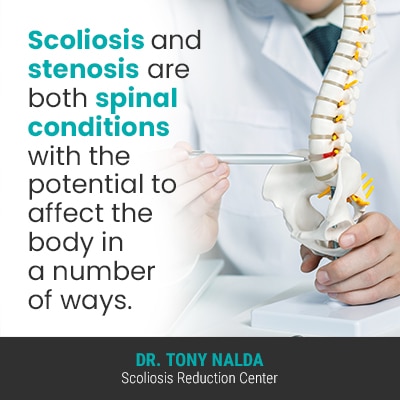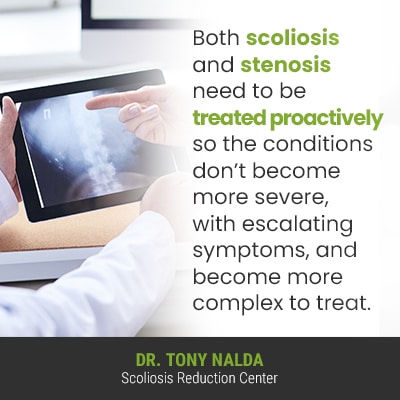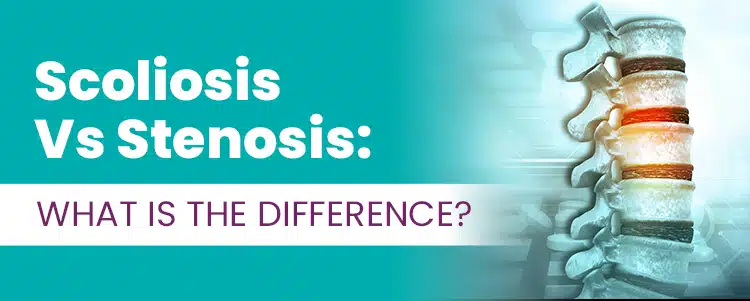The spine’s natural curves allow it to function optimally, and the spine enables flexible movement, strength, good posture, and remaining upright. In addition, the spine partners with the brain to form the body’s central nervous system, which is why spinal conditions can affect the body in so many different ways.
There are a number of spinal conditions a person can develop. Scoliosis involves the development of an unnatural spinal curve, while stenosis involves the narrowing of the space within the spine; both have degrees of nerve involvement.
While scoliosis involves the loss of healthy spinal curves, stenosis is the loss of healthy space within the spine, so let’s compare and contrast the two spinal conditions.
What is Scoliosis?
Scoliosis is the development of an unnatural sideways spinal curve that also rotates, making it a 3-dimensional condition.
In addition, in order to be diagnosed as scoliosis, the curve has to be of a minimum size: Cobb angle of 10 degrees.
A patient’s Cobb angle measurement is determined during X-ray.
When scoliosis is present, this means the unnatural spinal curve has shifted the spine out of alignment, disrupting its overall health, function, and strength.
The higher the Cobb angle, the further out of alignment a spine is, the more severe the condition, and the more likely its symptoms are to be noticeable:
Mild scoliosis: Cobb angle of 10+ degrees
Moderate scoliosis: Cobb angle of between 10 and 25 degrees
Severe scoliosis: Cobb angle of 40+ degrees
Very-severe scoliosis: Cobb angle of 80+ degrees
In addition to ranging widely in severity, scoliosis is a progressive spinal condition, meaning it has it in its nature to worsen over time.
Scoliosis is Progressive
So where a scoliosis is at the time of diagnosis is not always indicative of where it will stay; only proactive treatment can work towards counteracting the condition’s progressive nature.
While we don’t fully understand why many cases of scoliosis develop, we do understand what causes it to progress: growth and development.
Scoliosis introduces a lot of uneven forces to the body, disrupting its overall symmetry and causing postural deviation, in addition to pain (more common in adults).
Different Types/Causes of Scoliosis
There are also different types of scoliosis, based on unique causative sources. The most common is idiopathic scoliosis, and the idiopathic classification means we don’t fully understand the condition’s etiology, but that doesn’t mean we don’t know how to treat it.
Adolescent idiopathic scoliosis, diagnosed between the ages of 10 and 18 is the condition’s most-prevalent type.
In fact, idiopathic scoliosis makes up approximately 80 percent of known diagnosed cases, and the remaining 20 percent are associated with known causes: neuromuscular, degenerative, and congenital scoliosis.
Neuromuscular scoliosis is caused by the presence of a larger neuromuscular condition such as cerebral palsy, spina bifida, and muscular dystrophy, to name a few.
Degenerative scoliosis is mainly caused by natural age-related spinal degeneration, and cases of congenital scoliosis are caused by a malformed spine that develops in utero; infants are born with the condition.
Although scoliosis is a progressive and incurable spinal condition, it is highly treatable, especially when caught early and proactive treatment is applied.
Common Scoliosis Symptoms
Cases of scoliosis are wide ranging, from severity to type, and symptoms will also vary from patient to patient.
Some common symptoms of scoliosis include postural changes like uneven shoulders and hips, back pain (in adults), radiating pain into the extremities due to nerve involvement, muscle strain, weakness, and imbalance.
If scoliosis is left untreated and progresses, the risk of potential complications increases: lung impairment, digestive issues, migraines, sleep problems, etc.
Now that we’ve defined scoliosis and discussed some key condition features, let’s define stenosis.
What is Stenosis?
Spinal stenosis is the loss of space inside the spine, which introduces uneven pressure to the spine’s individual parts and the spinal nerves within.
There are three main sections of the spine: cervical spine (neck), thoracic spine (middle/upper back), and lumbar spine (lower back).
Most cases of spinal stenosis develop in the cervical and/or lumbar sections, and while not all patients experience noticeable symptoms, others can face pain, numbness, and muscle weakness.
Different Types/Causes of Spinal Stenosis
As mentioned, most often, stenosis affects the cervical and lumbar spinal sections, so this determines type: cervical stenosis, lumbar stenosis.
Symptoms of stenosis are closely tied to its location within the spine.
Spinal stenosis can be caused by bone spurs, a herniated disc, thickened ligaments, spinal injury/trauma, and the presence of spinal tumors.
Bone spurs are bony projections that occur on the vertebrae of the spine, and the overgrowth of bone can compress the spinal canal, and the spaces within, causing nerve compression and/or impingement.
Intervertebral discs sit between adjacent vertebrae, and if one becomes herniated, this means its inner nucleus has pushed through a tear in its outer annulus, and the protruding nucleus can encroach on the spaces within and around the spine, needed for spinal nerves to function within.
The spinal ligaments are like tough ropes that hold the vertebrae together; if one becomes thickened over time, it can become stiff and start to bulge outwards, projecting into the space within the spinal canal.
If the spine is exposed to a trauma and/or injury, such as a dislocation or vertebral fracture, the displaced bone can harm the inside of the spinal canal, and spinal surgery is also known to irritate nearby tissue, causing it to become inflamed, and introducing adverse pressure to the nerves of the spinal cord.
Stenosis Symptoms are Progressive
Like scoliosis, symptoms tend to progress if left untreated, increasing in severity over the years.
When symptoms start to develop, they tend to start gradually and get increasingly worse; this is particularly the case in older patients for whom age-related spinal degeneration is also occurring.
Symptoms will also vary based on the location of the stenosis within the spine and the degree of nerve involvement.
Some common symptoms of spinal stenosis include back pain, radiating pain due to compressed nerves, numbness, and/or weakness.
Scoliosis vs Stenosis

Scoliosis and stenosis are both spinal conditions with the potential to affect the body in a number of ways.
While scoliosis is an unnatural sideways spinal curve, stenosis involves the loss of space within the spine.
Scoliosis and stenosis both introduce uneven forces to their surroundings, and both can result in nerve compression, impingement, and/or inflammation.
Nerves are like branches on a tree, fanning off in multiple directions, which is why the effects of nerve compression can be felt far from where the compression starts, and both scoliosis and stenosis can cause radiating pain, and a variety of sensations, felts in the arms and legs, hands and feet.
While the majority of cases of scoliosis are idiopathic, in most cases of stenosis, there is a clear causative source, such as bone spurs, a herniated disc, and/or trauma experienced by the spine.
While the most common symptom of scoliosis in children and adolescents is postural deviation due to a disruption in the body’s overall symmetry, stenosis patients don’t experience such noticeable symptoms, which is why many patients learn about their stenosis while being examined for other issues.
Stenosis symptoms tend to escalate over time, especially if left untreated, and as a progressive condition, the same can be said of scoliosis.
Both scoliosis and stenosis, due to nerve involvement, have the potential to cause neuropathy, a condition where nerves exposed to compression, irritation, and/or impingement become damaged over time, which can lead to permanent effects.
Another shared feature of scoliosis and stenosis is that while the conditions can cause symptoms felt throughout the body due to nerve compression, the areas of the body located closest to the section of the spine with the stenosis/scoliosis is the section of the body most likely to feet its direct effects.
An important difference between the two conditions is that scoliosis affects all ages from infants to the elderly and every age in between, while being the most prevalent in adolescents; stenosis is a condition associated with adults experiencing spinal degeneration, and is a common cause of spinal surgery in older adults.

Both scoliosis and stenosis need to be treated proactively so the conditions don’t become more severe, with escalating symptoms, and become more complex to treat.
Conclusion
Scoliosis is a highly-prevalent spinal condition with close to seven million people currently living with it in the United States alone, and it is the most common spinal condition amongst school-aged children.
Studies have shown that approximately 1 in 1,000 people over the age of 65, and about 5 in every 1,000 people over the age of 50, will be diagnosed with spinal stenosis.
Scoliosis involves the development of an unnatural spinal curve, while stenosis is the narrowing of the spinal canal.
The spinal canal is home to 31 pairs of spinal nerves, so spinal conditions like scoliosis and stenosis have the potential to cause nerve compression, which can lead to a wide range of symptoms.
Both conditions can be treated surgically or nonsurgically, and while scoliosis is most prevalent in children and adolescents, stenosis is a condition that affects adults as they age and are experiencing increasing levels of spinal degeneration.




